Someone thinks that a huge number of moles on the body is a sign of a happy fate, while someone, on the contrary, believes that this is an alarming signal. From the moment of birth, moles on the human body appear all over the body, some of them increase in size.
What are moles?
Moles are small formations on the human body, often darker than the main skin tone, the reason for the appearance of moles lies in natural pigmented deformities.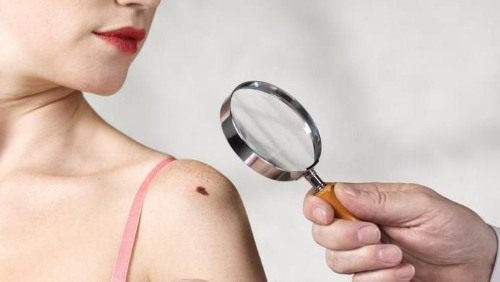
Causes of the appearance of moles
A number of factors affect the occurrence of moles on the human body - place of residence, climatic conditions, and the level of solar radiation. Residents of southern latitudes, as a rule, have more moles on their bodies, and this is directly related to solar activity. The appearance of moles on the human body is a normal process that begins in childhood and is most active in old age.
Differences between a dangerous mole and a harmless one
There are two types of moles on the human body. Normal - do not pose any threat to health and malignant - the condition of which must be monitored, deformations of such a mole can harm health. As dermatologists say, a mole from which hair grows - and this is often found on the human body - is definitely normal.
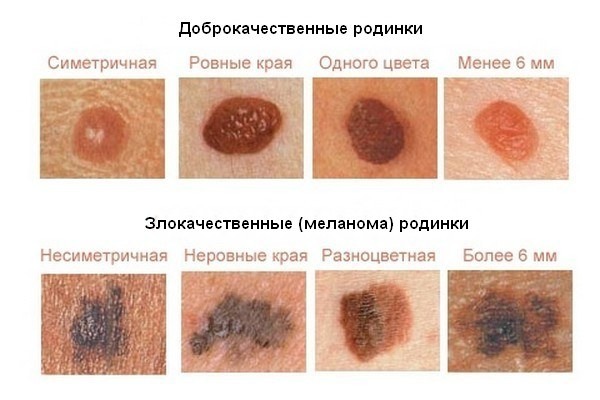
A malignant mole can attract your attention with a different shape, uneven color, excessive bulge.
Types of dangerous moles
There are several types of moles that may need your attention. Congenital nevi, which sharply change their shape or size, as well as bring discomfort - pain, itching, etc. should be examined.
Moles that reach a large size - more than 1 cm in diameter also need to be observed by a specialist. The red color of the mole is not yet a cause for concern. Such a formation can occur when a large number of capillaries accumulate in the layers of the epithelium.
Fibroepithelial nevus
This formation looks like a small ball up to one and a half cm in diameter.Fibroepithelial nevus has a soft structure, the color is similar in tone to the rest of the moles on the body. Before the end of puberty, such moles appear on the human body.
The reasons for the appearance are natural biochemical processes that occur less often in adulthood. Such a mole can only cause aesthetic discomfort.
Intradermal nevus
Another type of benign formations that form before the end of puberty. Most often they are localized at the places of skin folds - on the armpits, in the groin area. The main reason for the dermatological removal of such a skin formation is frequent trauma when shaving, removing and putting on clothes.
Papillomatous nevus
This type of moles is a convex formation on the surface of the skin with a bumpy structure. The name "papillomatous nevus" is associated with the external resemblance to papillomas on the human body.
Most often localized on the head, hides under the hair, and in most cases does not cause discomfort.
Setton's nevus
In terms of its symptoms, Setton's nevus is a mole on the human body that resembles the manifestation of Vitiligo - that is, discoloration (whitening) of the skin. The cause of the appearance may be an autoimmune disease or prolonged exposure to ultraviolet rays. This is the name given to a mole surrounded by a small patch of skin devoid of natural pigment.
Lentigo
"Senile freckles" - this is also the name of this type of pigmentation, which affects not only the elderly. These formations are flat, intradermal, and range in color from pale yellow to dark brown. The main reason for the occurrence of lentigo in old age is changes in hormonal levels, natural skin aging.
Heredity plays a big role in skin pigmentation, and knowing your “family phototype” you can choose the ideal time to spend in the open sun.
Atypical nevus
Some moles on the human body (typical), the owner himself does not notice immediately, others, such as, for example, an atypical nevus, the cause of which lies in a genetic predisposition and external influences, appear gradually, throughout life. Such moles reach a diameter of more than 1 cm, have fuzzy borders and an uneven color.
Mongolian spot
The Mongolian spot is an atypical bluish pigmented spot, most often localized in the pelvic region, on the buttocks. 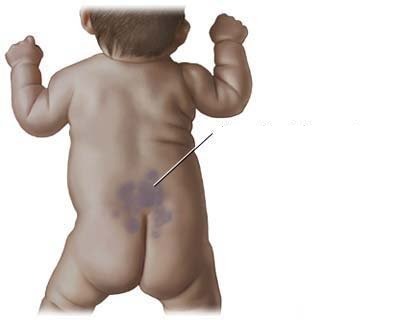
Are moles on the face dangerous?
Dermatologists say that moles on the human body most often have the highest concentration per cm2. skin on the face. The reason for the appearance of neoplasms in this area can also be found in the genes of the parents and grandparents. Moles on the face are not dangerous if you do not injure them, if they do not change in shape, color and texture.
Are large moles dangerous?
Large moles require medical supervision. Melanoma is a malignant formation with a risk of a tumor that differs from an ordinary mole in size (hypertrophy), irregular shape and a color different from other moles.
Particular attention should be paid to checking large moles and moles that are suspicious if a relative has skin cancer.
Is there a danger in raised moles?
The same can be said for raised moles. "Sagging" moles are dangerous because they are most susceptible to mechanical injury (they are easy to hurt when changing clothes), it is more difficult to hide from an excess of sunlight. However, it is possible to start removing such a mole only after consulting a dermato-oncologist.
Is there a danger in red moles?
The red color of the mole indicates the accumulation of a node of small capillaries under the skin. Red moles are not harmful to human health, but if discomfort occurs, including aesthetic one, consultation with a dermatologist is required. 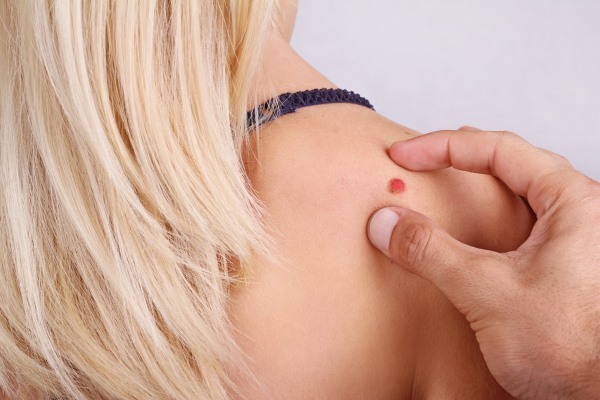
Is there a danger in hanging moles?
Hanging moles on the human body most often appear already in adulthood. The reason for their appearance is primarily the natural aging process and constant mechanical stress. It is for the second reason that such moles are most often localized in the armpit and on the neck. Such moles become dangerous when they change in size due to permanent damage.
Is there a danger in rough moles?
A mole with an irregular or rough surface occurs in a place subject to constant friction. Symmetrical and round moles with a rough surface and uniform color do not pose any danger.
Are moles with uneven edges dangerous?
Asymmetric moles are exactly the type of neoplasms that require specialist supervision. It is not even the shape of the mole itself that is important, but the dynamics of its development. Neoplasms that grow rapidly and change in shape and color must be shown to a dermatologist.
Which doctor should I contact if there is a suspicion that a mole is dangerous?
Every time you find a new mole on your body that makes you suspicious, you should consult a dermatologist. Some moles cannot be examined on their own; this requires proper lighting and a magnifying glass. 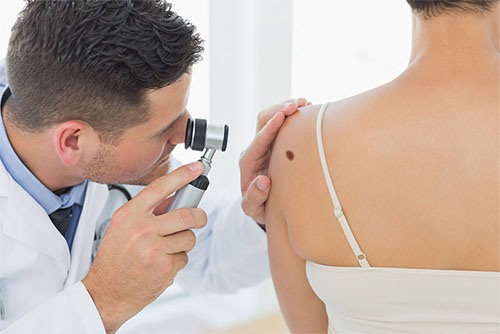
How is the diagnosis carried out?
Initial diagnosis by a dermatologist is carried out using a magnifying glass with an illuminated frame. The dermatoscope allows the specialist to determine the properties of the nevus and prevent skin diseases in the early stages. Samples of suspicious moles can be biopsied.
The difference between melanoma and a mole
Specialists of the "Skin Cancer Fighting Fund" together with the "SkinChecker" social project have compiled a "skin test" system, which allows you to independently distinguish malignant moles from ordinary “safe” nevi:
- Checking the symmetry of a mole - a normal mole has a slight asymmetry or is mirror-like.
- A normal nevus has neat, smooth edges, while a mole at the stage of melanoma development changes its shape, “spreads out”.
- A mole transforming into melanoma has several shades of color, for example, black and brown, and a normal mole in most cases is uniform in color.
- Malignant neoplasms grow larger than an eraser on the tip of a pencil, while a normal mole is usually small.
- Any changes in the nevus should be shown to a dermatologist to prevent the birthmark from turning into melanoma.

 Don't miss the most popular column article: Fashionable bangs of the new season for medium, short, long hair. A photo.
Don't miss the most popular column article: Fashionable bangs of the new season for medium, short, long hair. A photo.Can a mole turn into melanoma?
Yes, maybe such transformations also occur due to private mechanical irritation, prolonged exposure to solar radiation, changes in hormonal levels.
What anyone can do today to reduce the risk of moles progression to melanoma is to use a soft sponge when showering and to avoid areas of skin covered in moles when shaving.
What happens if you injure or tear off a mole?
You can not injure, rip off the skin areas covered with moles on purpose. If trauma has occurred, then the first thing to do is to provide yourself with medical assistance.Treat the injury with hydrogen peroxide and try to stop the bleeding, and then immediately go to the doctor's consultation and follow his instructions.
In some cases, a ripped off mole can be removed, but this is possible only in a clinical setting.
Is it dangerous if a mole grows?
The mole may begin to grow in size due to mechanical stress, for example, during frequent shaving or epilation. The growth of moles can be dangerous, so you need to monitor the changes with your doctor.
Is it dangerous if a mole itches?
If the mole is itchy, you should definitely see a specialist. In this case, the doctor will either make a positive conclusion - there may be allergic skin reactions, or hair growth from a mole, or will advise further observation.
What does bleeding from a mole mean?
Bleeding from a mole is a warning sign that cannot be ignored. In this case, you cannot self-medicate and postpone the examination of this area of the skin "on the back burner", but you can stop the bleeding yourself with chlorhexidine or hydrogen peroxide.
The reasons for this bleeding can be many - from banal carelessness to scratching due to an allergic reaction. But in the vast majority of cases, mechanical injury becomes the reason for bleeding.
Mole removal methods
Moles are removed in several ways. Moles are removed using electric current, laser, radio waves, invasive surgery, and liquid nitrogen. After removing the mole, a seam or scar should be observed that could remain from the procedure. The healing process usually does not take more than a week.
Doctors advise not to touch the crust formed at the site of the removed mole, do not rub this place with a washcloth or even a soft sponge while taking a shower.
The pink speck remaining after the crust has fallen off should be protected as much as possible from exposure to sunlight. To do this, use tight clothing, sunscreen with high protective filters, or apply a protective bandage to the skin surface where the mole is removed.
Removal with a laser
Laser removal of moles is an “attack” of a neoplasm with a concentrated beam of light. 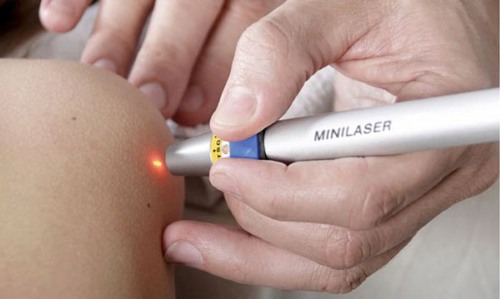
Surgical removal
Surgical intervention is used to remove large, convex and dense moles. Local anesthesia is used, which makes the procedure painless. 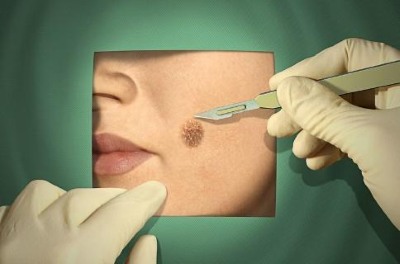
X-ray radiation
X-rays are one of the causes of birthmarks. It is an irritating factor that "pushes" pigmented cells closer to the surface of the epidermis.
X-rays have a number of effects on human biological systems.
Thus, an abundant dose of radiation can change the chemical composition of the blood, as well as lead to the immutability of the new, transformed composition, increasing the risk of cataracts and cancers. But all these negative consequences await those who are constantly and for a long time exposed to direct radiation.
Cryodestruction
Moles located in the upper layers of the skin are recommended to be removed using a cryodestruction procedure - that is, by freezing. During the removal of the mole, the patient may feel numbness in the area of the skin to which cotton wool “soaked” with liquid nitrogen is applied.
Destructive (destructive) mole removal is used in cases of deep "germination" of the mole into the skin. With the help of a needle, the mole is frozen “from the inside”.
A liquid nitrogen
Liquid nitrogen is a low temperature liquefied gas. When used correctly, it is not hazardous to humans. Used in industry, medicine and cosmetology.
There are several disadvantages to performing the mole removal procedure using liquid nitrogen:
- Firstly, there is a possibility that the mole is not completely removed and the procedure will have to be repeated.
- Secondly, the removed mole cannot be used as a biopsy material.
Radio wave removal
Removing moles using radiation is a method that has long been practiced in medicine. This is the least traumatic method that allows you to cut the skin without contact and tighten it, restoring damaged tissue. However, for people with pacemakers, this method of removing moles will not work.
Moles are a part of our body that needs to be closely monitored. The condition of the moles that bother you should not be started, you should consult a doctor as soon as you notice changes. Checking moles is a matter of five minutes, which can cost you and your loved ones decades of health.
Electrocoagulation
This method is used to remove moles on the face. Small moles on the human body are removed. The reason for the appearance of such a limitation is the possible trauma to the skin, the occurrence of scars. The doctor preliminarily performs local anesthesia. Layer by layer, the skin is cut off with an electrocoagulator, then the damaged tissues are connected and restored.
Video about the causes of the appearance of moles on the body
The causes of the birthmark, see the video clip:
Whether moles on the body are dangerous, find out in the video clip:

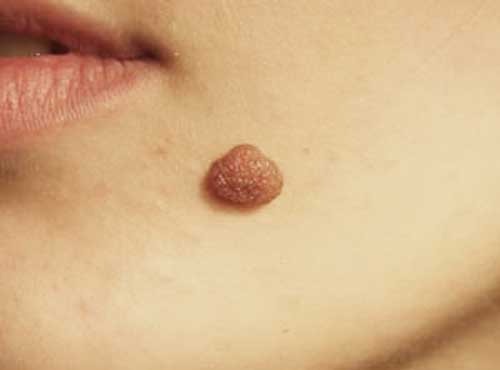
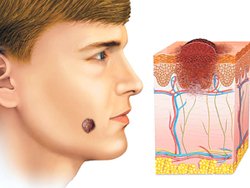
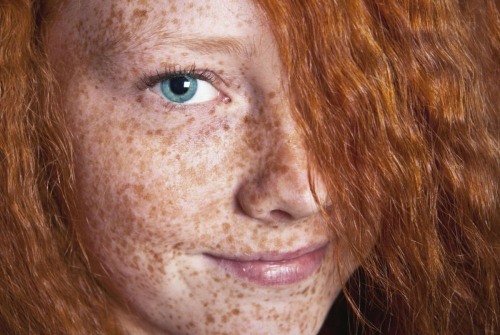
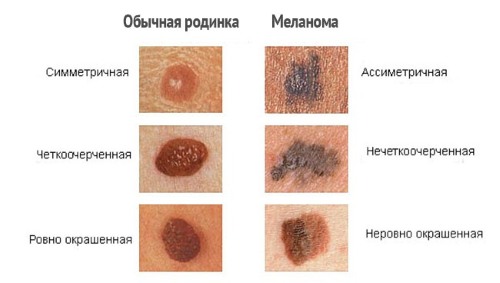
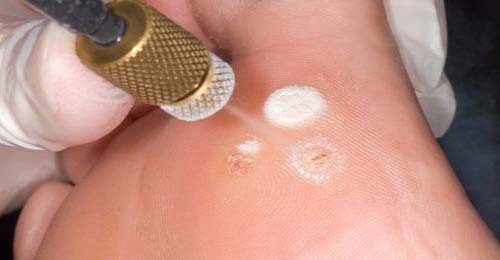
I have a lot of red moles on my chest. judging by the words of the author, it is not dangerous. But I guess I'll still go to a dermatologist to be sure.